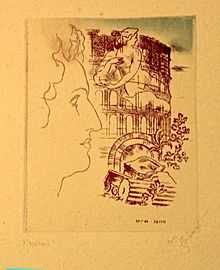Roman Elegies

Soviet illustration by Ignatiy Nivinskiy, 1933
The Roman Elegies (originally published under the title Erotica Romana in Germany, later Römische Elegien) is a cycle of twenty-four poems by Johann Wolfgang von Goethe. They reflect his Italian Journey 1786-88 and celebrate the sensuality and vigour of Italian and Classical culture. Written mainly after his return to Weimar, they contain poems on many sexual themes, and four of them were suppressed from publication during Goethe's lifetime due to fears of [censorship]; they were only published in 1914, together with a large body of the Venetian Epigrams, written during his second, shorter travel to Italy in 1790. The elegies are also a loving tribute to Goethe's companion, Christiane Vulpius, whom he met in 1788 on his return from Italy.[1]
References
- ↑ Rainer Hillenbrand: Goethes Römische Elegien als fiktionales Kunstwerk. Frankfurt a.M. 2003. ISBN 3-631-51248-1
External links
|
|---|
| | Poems | | |
|---|
| | Plays | |
|---|
| | Prose | |
|---|
| | Autobiographical works | |
|---|
| | Journals | |
|---|
| | Natural sciences | |
|---|
| | Conversations | |
|---|
| |
|
